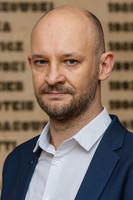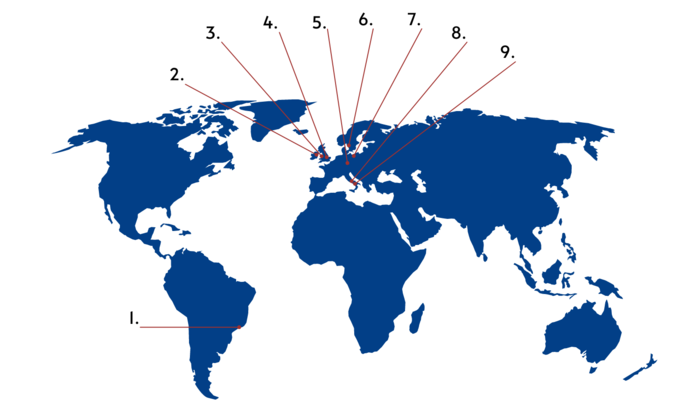Subject Area and Research Team: IX. Technological developments for bioanalysis and therapy including cell based, 3D and artificial engineered models
Research topics
1. Experimental nanomedicine
2. Targeted therapy for pancreatic and breast cancer. Mechanism of resistance and progression
3. Biomaterials and regenerative medicine. Wound healing and cartilage regeneration
4. Antibacterial Peptides (AMPs) & Biosensors
5. The study of brain energy metabolism
6. Use spore as universal carriers, social interaction between B. subtilis and D. solani and bacteriophages of Clostridium dificile
7. Pharmaceutical Technology & Biopharmacy
Coordinators
| Coordinator #1 | Coordinator #2 | Coordinator #3 | |
|---|---|---|---|
| Name and surname |  |
 |
 |
| Academic degree | Prof. Dr. Habil. | Prof. Dr. Habil. | Assoc. Prof. Dr. Habil. |
| Employment unit | Department of Embryology | Department of Pharmaceutical Patophysiology | Department of Molecular Enzymology and Oncology |
| Polish Platform of Medical Research | Prof. Dr. Habil. Michał Pikuła | Prof. Dr. Habil. Iwona Inkielewicz-Stępniak | Assoc. Prof. Rafał Sądej, Dr. Habil. |
| michal.pikula@gumed.edu.pl | iwona.inkielewicz-stepniak@gumed.edu.pl | rafal.sadej@gumed.edu.pl | |
| Phone number | +48 58 523 13 68 | +48 58 349 15 16 | +48 58 349 14 70 |
Research Team IX. Technological developments for bioanalysis and therapy including cell based, 3D and artificial engineered models
Team Members IX. Technological developments for bioanalysis and therapy including cell based, 3D and artificial engineered models (159 KB)Feel free to contact our coordinator to join the Research Team.
Key current projects
1. Nanodrugs as a new approach in therapy of cardiovascular diseases, cancer and tumour-associated angiogenesis
2. Establishment of pancreatic cancer organoids model for drug and nanodrug screening
3. Analysis of FGFR-mediated regulation of autophagy in breast cancer progression and response to endocrine therapies
4. New generation bioactive molecules delivery systems, based on chemically synthesised and obtained through genetic engineering nanobiomaterials
5. Analysis of mechanisms of resistance to innovative FGFR kinases inhibitor – development of novel anti-cancer therapy
6. Antimicrobial peptides design and synthesis
7. Metabolism of adenine nucleotides in regulation of cancer progression and promotion
8. Social interaction between B. subtilis and D. solani, bacteriophages of Clostridium dificile
9. Lipid microparticles nanoparticles and lyophilized formulations
10. Ocular and transdermal penetration
Key grants
| Funding agency/grant number | Principal investigator(s) | Title of the project | Years | |
|---|---|---|---|---|
| 1. | NCN, OPUS 18, 2019/35/B/NZ7/04212 |
Prof. Iwona Inkielewicz-Stępniak | Synthetic analogues of opioid growth factor linked to derivatives of glucosamine as a compounds with the potential for targeted therapy against pancreatic tumour | 2020-2024 |
| 2. | NCN, HARMONIA 9, 2017/26/M/NZ7/01030 |
Prof. Iwona Inkielewicz-Stępniak | Antithrombotic and antimicrobial activity of functionalized silver nanoparticles performed under in vitro, ex vivo condition and on animal model | 2018-2022 |
| 3. | H2020, EU-funded, Marie Skłodowska-Curie – 861196 | Prof. Iwona Inkielewicz-Stępniak | PRECODE Network PancREatic Cancer OrganoiDs rEsearch | 2019-2023 |
| 4. | NCN, OPUS 17, 2019/33/B/NZ7/02676 |
Prof. M. Pikuła | Effect of adipose-derived stem cells on in vitro cultured skin cells obtained from patients undergoing chemotherapy | 2020-2023 |
| 5. | TECHMATSTRATEG2/410747/11/NCBR2019 | Prof. M. Pikuła | New generation bioactive molecules delivery systems, based on chemically synthesised and obtained through genetic engineering nanobiomaterials, Bionanova | 2019-2022 |
| 6. | NCN, Opus 14, 2017/27/B/NZ3/01474 |
Prof. R. Sądej | Significance of FGFR2 in regulation of autophagy in breast carcinoma – implications for disease prognostication | 2018-2021 |
| 7. | NCN, OPUS 12, 2016/23/B/NZ7/02919 |
Prof. Wojciech Kamysz | Research on the use of new analogs of endogenous peptides in the treatment of skin infections of staphylococcal etiology | 2017-2021 |
| 8. | NCN, OPUS 15, 2018/29/B/NZ9/02339 |
Prof. Michał Obuchowski | Social interaction between B. subtilis and D. solani | 2018-2021 |
| 9. | NCN, OPUS 15, 2018/29/B/NZ7/01111 |
Prof. Małgorzata Sznitowska | Comparative analysis of structural and diffusive properties of adhesive polymer based carriers used in medicated patches applied to the skin | 2019-2022 |
International cooperation
| Foreign partner (unit name) | Principal investigator(s) | Area of cooperation | |
|---|---|---|---|
| 1. | Instituto Nacional de Ciência e Tecnologia em Entomologia Molecular, Universidade Federal do Rio de Janeiro, Rio de Janeiro, Brazil | Ana C. A. Melo | Preparation of molecular receptors (odorant binding proteins, olfactory receptors) |
| 2. | Trinity College, Dublin, Ireland | Maria Jose Santos-Martinez | In Vitro Microvessel Models |
| 3. | University of Birmingham, UK | Fedor Berditchevski | Constructs exchange, project realisation |
| 4. | Transplantation Research and Immunology Group, Nuffield Department of Surgical Sciences, University of Oxford, Oxford, England | Joanna Hester | Immunological studies, NAWA program scholarship |
| 5. | University of Erlangen, Nuremberg, Germany | Christian Pilarsky | Pancreatic Cancer Organoids |
| 6. | Department of Chemistry and Chemical Engineering,Chalmers University of Technology, Goeteborg, Sweden | Anette Larsson | Structural analysis of polymeric materials |
| 7. | University of Greifswald, Department of Biopharmaceutics and Pharmaceutical Technology, Center of Drug Absorption and Transport (C_DAT), Greifswald, Germany | Werner Weitschies | Biorelevant dissolution tests |
| 8. | University Frederico II, Naples, Italy | Ezio Ricca | B. subtilis spore |
| 9. | Department of Electronic Engineering; Department of Chemical Science and Technology, Tor Vergata, University of Rome, Rome, Italy | Corrado Di Natale | Design and construction of (bio)sensor arrays |

Key publications
1. Hajtuch J, Hante N, Tomczyk E, Wojcik M, Radomski MW, Santos-Martinez MJ, Inkielewicz-Stępniak I. Effects of functionalized silver nanoparticles on aggregation of human blood platelets. Int. J. Nanomed. 2019; 14: 7399-7417.
2. Budka J, Kowalski Sz, Dzierzbicka K, Inkielewicz-Stepniak I. Opioid Growth Factor and its Derivatives as Potential Non-toxic Multifunctional Anticancer and Analgesic Compounds. Current Medicinal Chemistry. 2021; 28(4): 673-686.
3. Deptuła M, Karpowicz P, Wardowska A, Sass P, Sosnowski P, Mieczkowska A, Filipowicz N, Dzierżyńska M, Sawicka J, Nowicka E, Langa P, Schumacher A, Cichorek M, Zieliński J, Kondej K, Kasprzykowski F, Czupryn A, Janus Ł, Mucha P, Skowron P, Piotrowski A, Sachadyn P, Rodziewicz-Motowidło S, Pikuła M. Development of a Peptide Derived from Platelet-Derived Growth Factor (PDGF-BB) into a Potential Drug Candidate for the Treatment of Wounds. Adv Wound Care. 2020; 9(12): 657-675.
4. Sass P, Sosnowski P, Podolak-Popinigis J, Górnikiewicz B, Kamińska J, Deptuła M, Nowicka E, Wardowska A, Ruczyński J, Rekowski P, Rogujski P, Filipowicz N, Mieczkowska A, Peszyńska-Sularz G, Janus Ł, Skowron P, Czupryn A, Mucha P, Piotrowski A, Rodziewicz-Motowidło S, Pikuła M, Sachadyn P. Epigenetic inhibitor zebularine activates ear pinna wound closure in the mouse. EBioMedicine. 2019; 46: 317-329.
5. Piasecka D, Braun M, Mieszkowska M, Kowalczyk L, Kopczynski J, Kordek R, Sadej R, Romanska HM. Upregulation of HIF1-α via an NF-κB/COX2 pathway confers proliferative dominance of HER2-negative ductal carcinoma in situ cells in response to inflammatory stimuli. Neoplasia. 2020; 22: 576-589.
6. Braun M, Piasecka D, Tomasik B, Mieczkowski K, Stawiski K, Zielinska A, Kopczynski J, Nejc D, Kordek R, Sadej R, Romanska HM. Hormonal receptor status determines prognostic significance of FGFR2 in invasive breast carcinoma. Cancers. 2020; 12(9): 2713.
7. Kamysz E, Sikorska E, Jaśkiewicz M, Bauer M, Neubauer D, Bartoszewska S, Barańska-Rybak W, Kamysz W. Lipidated analogs of the LL-37-derived peptide fragment KR12 – structural analysis, surface-active properties and antimicrobial activity. Int. J. Mol. Sci. 2020; 2: 1-22.
8. Ronowska A, Gul-Hinc S, Michno A, Bizon-Zygmańska D, Zyśk M, Bielarczyk H, Szutowicz A, Gapys B, Jankowska-Kulawy A. Aggravated effects of coexisting marginal thiamine deficits and zinc excess on SN56 neuronal cells. Nutritional Neuroscience. 2019; 24(8): 1-11.
9. Grela A, Jamrożek I, Hubisz M, Iwanicki A, Hinc K, Kaźmierkiewicz R, Obuchowski M. Positions 299 and 302 of the GerAA subunit are important for function of the GerA spore germination receptor in Bacillus subtilis. Plos ONE. 2018; 13(6): e0198561.
10. Płaczek M, Wątróbska-Świetlikowska D, Stefanowicz-Hajduk J, Drechsler M, Ochocka JR, Sznitowska M. Comparison of the in vitro cytotoxicity among phospholipid-based parenteral drug delivery systems: emulsions, liposomes and aqueous lecithin dispersions (WLDs). Eur. J. Pharm. Sci. 2019; 127: 92-101.